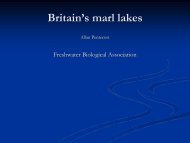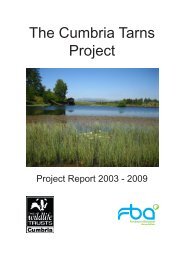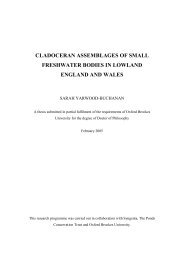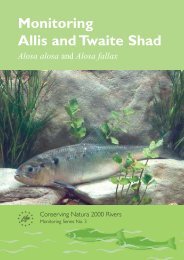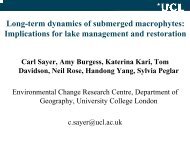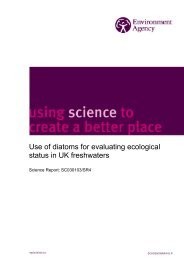Groundwater HIA post edit - FreshwaterLife
Groundwater HIA post edit - FreshwaterLife
Groundwater HIA post edit - FreshwaterLife
You also want an ePaper? Increase the reach of your titles
YUMPU automatically turns print PDFs into web optimized ePapers that Google loves.
3 Background to the<br />
methodology<br />
3.1 Development criteria<br />
In developing the <strong>HIA</strong> methodology for groundwater abstractions, certain general<br />
criteria were applied. These were that the <strong>HIA</strong> methodology must:<br />
• be risk-based; that is, the effort and resources used to assess the impacts<br />
should be matched to the level of risk of environmental damage.<br />
• emphasise the importance of developing a robust conceptual model of the<br />
site that is continually reviewed and updated as new information is<br />
collected.<br />
• be able to distinguish between impacts caused by changes in flow, and<br />
those caused by changes in water level, and deal with them appropriately.<br />
• result in an appropriate level of on-going monitoring, targeted at the issues<br />
of real concern.<br />
• if relevant, take into account the mitigation of impacts by the return of water<br />
to the groundwater or surface water system.<br />
• be able to cope with a variety of spatial scales (regional and local, for<br />
example).<br />
In addition, the <strong>HIA</strong> methodology is designed to be compatible with the Government’s<br />
principles of modern regulation. Five principles to be applied to any modern regulatory<br />
regime have been set out by the Better Regulation Taskforce (Environment Agency,<br />
undated). The regime must be:<br />
Transparent, with clear rules and processes;<br />
Accountable, leading to decisions that can be justified;<br />
Consistent, with the same approach being applied across sectors;<br />
Proportionate, according to the risks involved;<br />
Targeted, with a clear environmental outcome.<br />
Many environmental impacts arising from a groundwater abstraction will occur close to<br />
the abstraction point, especially those caused by changes in the water levels in the<br />
surrounding aquifer. However, some impacts caused by changes in flow may occur<br />
many kilometres from the abstraction, months or even years after the abstraction has<br />
commenced. Most groundwater abstractions are ultimately at the expense of surface<br />
water flows, whether they induce additional leakage from rivers or intercept water that<br />
would otherwise have discharged to them. Hydrogeological investigations are often<br />
undertaken at two scales, regional and local:<br />
Regional scale: typically at the level of groundwater management units, such as those<br />
used in the CAMS process, or groundwater bodies as defined by the Water Framework<br />
Directive. At this scale, the impact of an individual abstraction may be of little<br />
significance, but the cumulative impact of all the abstractions may very well be<br />
14 Science Report – Hydrogeological impact appraisal for groundwater abstractions






